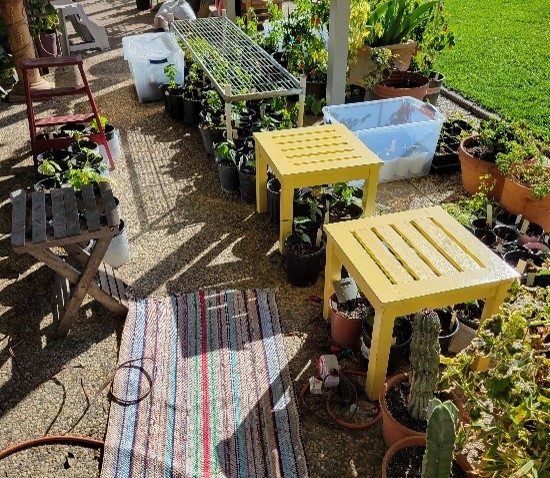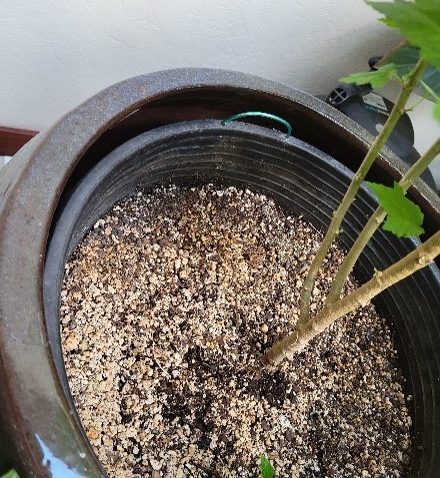
by Stan Logan | Feb 20, 2022 | Container plants
 |
Many of you have really large flowerpots. If your pots are narrower at the opening, you have a problem when it comes to removing the plant. If you want to save the plant, extracting it from its vessel can be difficult. One solution it to break the pot—not the ideal option. Now if you don’t care for the plant, the chore of removing it and the soil can still be difficult. I have written you before about using a soil auger, and that will work.
Another option you might consider is planting your valued plant in an inexpensive plastic pot—one that is tapered for easy plant removal. The plastic pot can be raised to the desired height with wood blocks, bricks, or rocks placed beneath it. This also creates room for water run off if your large pot has no drainage holes. You can see in the photo I have drilled two holes in the rim of the plastic pot and inserted wire to make handles that will allow me to lift the pot out.
There are so many beautiful large planters out there at nurseries. I can see how you would be tempted to buy one that narrows at the top. Please consider using a second pot inside—call it pot insurance.
Stan, The Pot Man |
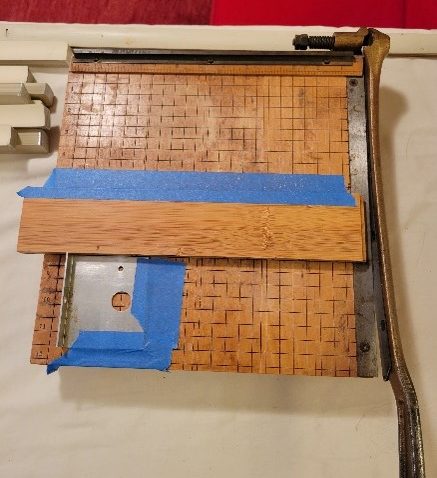
by Stan Logan | Feb 19, 2022 | Plant labels
I prepare plant labels for both the Sacramento Iris Society and the Sacramento Perennial Plant Club. The labels for the Iris Club are cut to around 10 inches and are made of aluminum. The labels for the Perennial Club are cut to 5 inches and are made of plastic. We have found that plastic is easier to write on, and these labels always have a lot in information on them.
Now, I have shown below the two devices I use for label preparation. You can see the metal stop that is taped to the guillotine table. The length to which metal blinds are cut depends on the distance between the cord holes in the blinds.
After the blinds are cut to desired length, I tape a bunch together, and round the corners on an inverted belt sander. The bunches of the same length are then washed in a bucket with a dish washing solution. Then comes the fun part when I dry the labels while watching TV. The last label drying event was Sunday while watching the Super Bowl.
So, you see, someday I may have to pass this duty to another person. LaVille has refused. I really like making labels, and I am hoping there is someone out there who will take over this enjoyable task in the future.
Stan, The Blind Man (mini, that is)

Cutting Board used to right-size blinds into plant labels
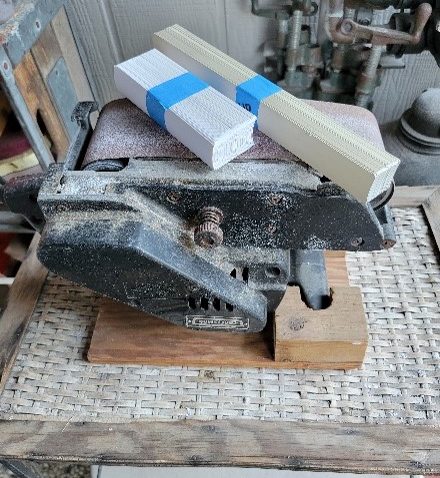
Plant labels made from blinds
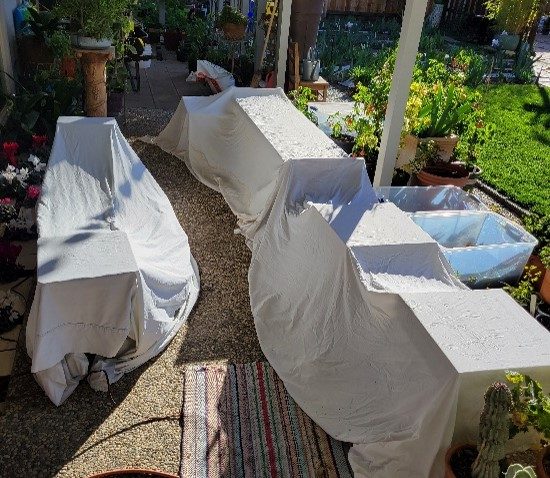
by Stan Logan | Feb 19, 2022 | Container plants, Garden tools, Propagation
With the advent of a freeze forecasted for the 22nd, I thought it timely to remind you to protect your tender plants. Although there are special sheet-like products available, old bed sheets will work fine. Got no old sheets? Then plan on going to estate sales. They are a sure find. In the photos below I have placed old X-mas tree lights (estate sales again) beneath the sheets. These maintain a temperature above 50 degrees through the night to protect the abutilon seedlings that are growing for future sales. If you plan on using plastic sheeting, don’t let the plastic touch the plants.
I just went outside to take a photo of the plants that the sheets were protecting. The abutilons have really grown well through the winter for the last 3½ months since cutting. We lift off the yellow tables each morning. A timer controls the lights, and that rug is a deterrent from tripping over the cords. The south exposure creates an extra 10 degrees of air temperature, and the pots most exposed to the sun are wrapped with white bubble wrap.
Stan, The Propagation Systems Manager Man
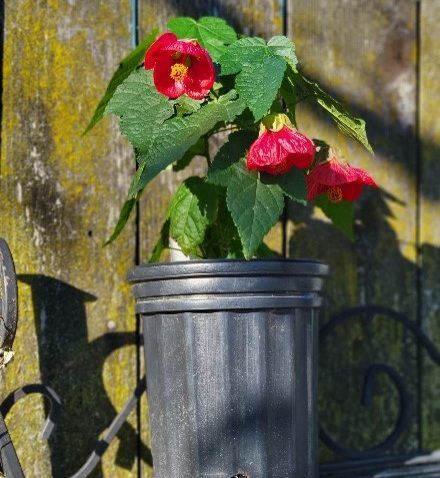
by Stan Logan | Feb 19, 2022 | Propagation
| Just look at thia photo. Can you not fall in love with a beauty like this? This abutilon is growing from a cutting obtained from a small tree growing in a friend’s back yard. This particular variety is a miniature that typically grows to about 18 inches, but in Sharon’s yard it has stretched up to four feet in search of more light. LaVille so loves abutilons that she is propagating 10 different varieties. These are practically the only outdoor plants that she is working with in preparation for club sales. Instead, she is growing many different indoor plants with an emphasis on begonias, hoyas, and peperonias since these plants are easy sellers.
Look for LaVille at the next Perennial Club sale. She is willing to share the love with you.
Stan, The Lover Man |
 Abutilon |
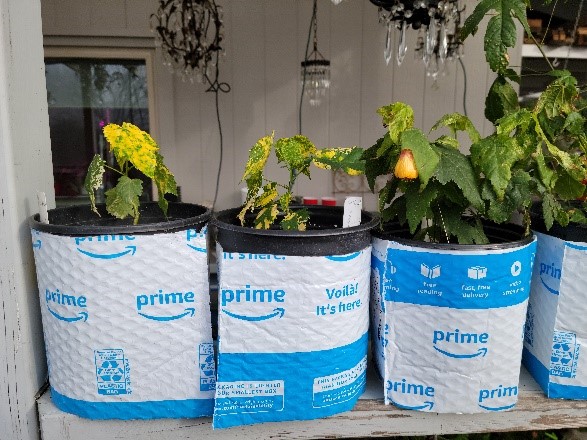
by Stan Logan | Feb 18, 2022 | Container plants, Irrigation
| Growing plants in those ubiquitous black gallon pots can pose a problem. Some plants prefer full sun exposure. However, intense sun rays are absorbed by the black plastic surface and converted into heat. When the planting soil within get hot, root damage results. One solution to this dilemma is to line the insides with bubble wrap. A much easier solution is to shield the outside. I have found the perfect heat barrier. Amazon sends a lot of its items in white bubble wrap pouches. The most common size they use fits around a gallon pot perfectly. If you cut the bottom off and cut the height in half to about 6 ½ inches, you will create tubes that will easily enclose two pots, keeping them cool, and yet allowing the full exposure of the sun to your happy plants. This technique creates a reusable shield that will postpone recycling and most certainly prevent deposit in the local landfill. If you are receiving Amazon Prime delivery pouches and have no use for them, we could certainly use them. LaVille, for instance, transferred 30 abutilons into gallon pots today. However, LaVille says I can’t order more stuff from Amazon just to get more bags.
Stan, The Reusing Man
P.S. I measured the temperature of the soil 1 inch from the edge of a shielded and an unshielded pot today at 3 PM. Shielded – 74 degrees Unshielded – 94 degrees. These are the results at the end of January. Imagine the results in August!
P.P.S. If the sight of all the advertising bothers you, turn the tubes inside out, but I’m not sure the shields will be as effective. I’ll test that out tomorrow and send you another email if there is significant difference. |
 Bubble-wrapped pots |
| |
|






